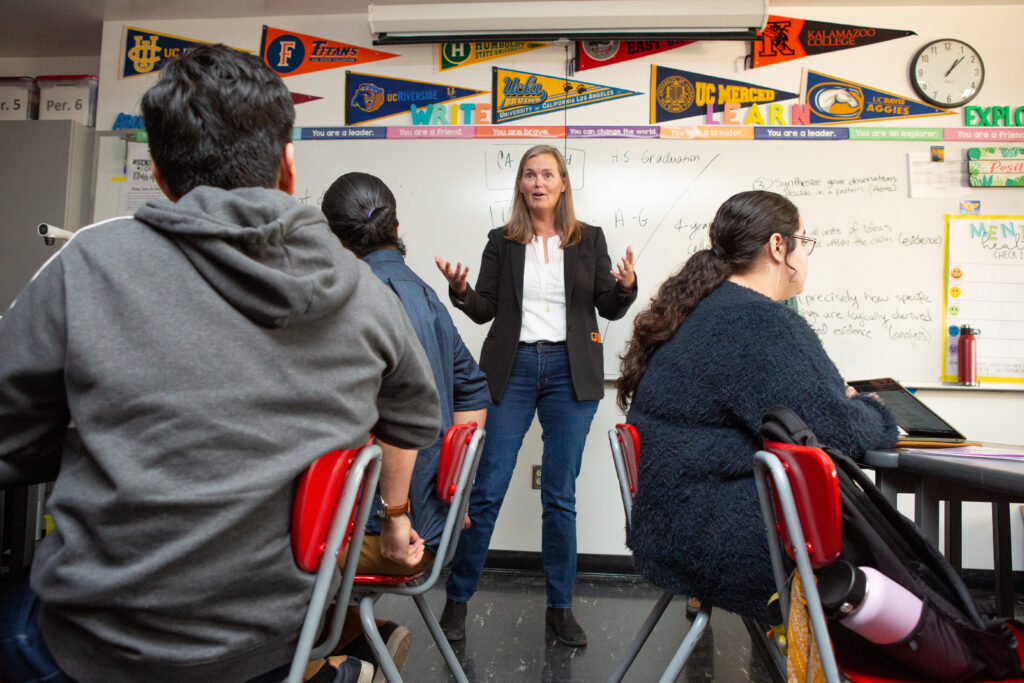
Credit: Allison Shelley for American Education
About 1 in 3 students in California’s K-12 schools speak a language other than English at home and were not fluent in English when they first started school — 1,918,385 students — according to data from the 2024-25 school year.
About half of these students (1,009,066) are current English learners. The rest (909,319) have learned enough English in the years since they started school to now be considered “fluent English proficient.”
How does a student become designated an English learner?
When a family enrolls a student in school for the first time, they are asked to fill out a survey about the languages the child speaks. If the child speaks a language other than English — even if they also speak English — the school is required to test the child’s English proficiency and decide based on that test whether the child is an English learner.
If the test — the English Language Proficiency Assessments for California, or ELPAC — shows the student to be proficient in reading, writing, speaking and listening in English, they are designated as “Initially Fluent English Proficient” and no longer have to take an English proficiency test again. If the test shows the student is not proficient in English, then they are designated as an English learner. Every spring after that, they must retake the English proficiency test until they are reclassified as “fluent English proficient,” based on this test and how they do on academic tests in English Language Arts, in addition to parents’ and teachers’ perspectives.
How does the population of English learners change over time?
As students advance through elementary and middle school, more of them are reclassified as fluent and English proficient each year, as shown by the illustration below. When students learn enough English to be reclassified as “fluent English proficient,” they are no longer considered English learners. At the same time, new students enroll for the first time in California public schools and are added to the English learner group every year in every grade.

Where are these students from?
The vast majority of English learners were born in the U.S. Among California K-12 students who said they spoke English “less than very well,” 72% were born in the U.S., according to an analysis of the U.S. Census Bureau’s 2016 American Community Survey by the Migration Policy Institute. A higher proportion of English learners in grades 6-12 were born outside the country (45%) compared to grades K-5 (13%).
How many are recent immigrants?
In 2023-24, there were 189,634 recent immigrant students in California who were not born in the U.S. and had not been attending school in the U.S. for more than three full academic years, according to the California Department of Education.
What languages do they speak?
California TK-12 students speak more than 100 different languages other than English. The most common language spoken in California other than English is Spanish — 74.27% of current or former English learners in 2024-25 spoke Spanish, according to the California Department of Education.
The second most common language spoken by current and former English learners in 2024-25 was Mandarin, spoken by 3.57% of these students. The third most common language was Vietnamese, spoken by 2.65%. After that were Cantonese, Arabic, Russian, Korean and Philippine languages, in that order.
How long does it take for students to learn English?
Research shows it normally takes students between four and seven years to learn academic English proficiently.
Only 7.6% of 2024-25 first graders who started school as English learners had been reclassified as “fluent English proficient” in the short time they had been in school. The percentage increases in every grade — among sixth graders who started school as English learners, for example, 45.4% had been reclassified; among eighth graders who started school as English learners, 62.3% had been reclassified; among 12th graders, 73.2% had been reclassified. It’s important to note that the total number of English learners also includes students who started school in later grades and have been enrolled for less time.
Where do they go to school?
There are English learners and former English learners in almost every school district in California, but the percentage varies widely. For example, 85.7% of students in Calexico Unified School District in Imperial County near the border with Mexico, started school as English learners, but only 4.3% of students in Dehesa School District in San Diego County were ever English learners.
How can you tell how well a school is serving its English learners?
The English Language Progress Indicator measures English learner progress by showing how many English learners progressed at least one level on the ELPAC, maintained the same level as the previous year, or decreased one or more levels. You can look up your school’s progress on the California School Dashboard.
Another measure is the reclassification rate — the number and percentage of English learner students who reclassify each year. However, the California Department of Education has not published this rate since 2020-21.
You can also measure a school district’s English learner progress by looking at the number of students who are “long-term English learners” and “at-risk of becoming long-term English learners.” Long-Term English Learners, or LTELs, are students in 6-12th grade who have been enrolled in a U.S. school for at least six years but have remained at the same English language proficiency level on the ELPAC for two or more consecutive years or regressed to a lower English language proficiency level. Students “at risk of becoming Long-Term English Learners” are in third-12th grade, have been enrolled in U.S. schools for four to five years and scored at the intermediate level or below on the ELPAC.
Are academic test scores good measures of English learners’ performance?
By definition, students who are designated as English learners are not yet proficient in academic English reading and writing, so it makes sense that they would not do well on academic tests in English. In fact, in many districts, students must do well on those tests, in addition to the English proficiency test, in order to be reclassified as “fluent English proficient.” When students do become proficient in English and are reclassified, they are no longer included in the English learner category. These students tend to do better on tests than students who speak only English at home.
What do other measures like graduation rates tell us about English learners?
Graduation rates tend to be low for English learners, as are other college and career preparation measures, such as how many A-G courses students have completed. (These courses are required for enrollment in the University of California and California State University systems.) However, it is important to keep in mind that the California Department of Education only publishes these measures for current English learners in high school, many of whom are recent immigrants. The department does not publish these measures for students who were once English learners and have since reclassified.











